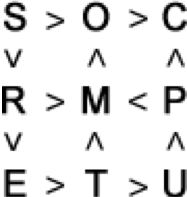Problems
The best student in the class, Katie, made up a huge number, writing out in a row all of the natural numbers from 1 to 500: \[123 \dots 10111213 \dots 499500.\] The second-best student, Tom, erased the first 500 digits of this number. What do you think, what number does the remaining number begin with?
Decipher the puzzle shown in the diagram.
Fred and George together with their mother were decorating the Christmas tree. So that they would not fight, their mother gave each brother the same number of decorations and branches. Fred tried to hang one decoration on each branch, but he needed one more branch for his last decoration. George tried to hang two toys on each branch, but one branch was empty. What do you think, how many branches and how many decorations did the mother give to her sons?
The farmer must transport across a river a wolf, a goat and a cabbage. The boat accommodates one person, and with him/her either a wolf, a goat, or a cabbage. If you leave the goat and the wolf unattended, the wolf will eat the goat. If you leave cabbage and goat without supervision, the goat will eat the cabbage. How can the farmer transport his cargo across the river?
In Neverland, there are magic laws of nature, one of which reads: “A magic carpet will fly only when it has a rectangular shape.” Frosty the Snowman had a magic carpet measuring \(9 \times 12\). One day, the Grinch crept up and cut off a small rug of size \(1 \times 8\) from this carpet. Frosty was very upset and wanted to cut off another \(1 \times 4\) piece to make a rectangle of \(8 \times 12\), but the Wise Owl suggested that he act differently. Instead he cut the carpet into three parts, of which a square magic carpet with a size of \(10 \times 10\) could be sown with magic threads. Can you guess how the Wise Owl restructured the ruined carpet?
Replace each letter in the diagram with a digit from 1 to 9 so that all the inequalities are satisfied,

and then arrange the letters in numerical order of their numerical values. What word did you get?
The old shoemaker Carl sewed some boots and sent his son Hans to the market to sell them for £25. Two disabled people came to the boy’s market stall (one without a left leg, the other without a right one) and was asked to sell each of them a boot. Hans agreed and sold each boot for £12.50.
When the boy came home and told the whole story to his father, Carl decided that his son should have sold the boots to the disabled buyers for less – each for £10. He gave Hans £5 and ordered him to return £2.50 to each disabled buyer.
While the boy was looking for the disabled people at the market, he saw that someone was selling sweets and as could not resist, spent £3 on sweets. After that, he found the disabled buyers and gave them the remaining money – each got £1. Returning home, Hans realised how badly he had acted. He told his father and asked for forgiveness. The shoemaker was very angry and punished his son by sending him to his room.
Sitting in his room, Hans thought about the day’s events. It turned out that since he returned £1 to each buyer, they paid £11.50 for each boot: \(12.50 - 1 = 11.50\). So, the boots cost £23: \(2 \times 11.50 = 23\). And Hans spent £3 on sweets, therefore, it total, there were £26: \(23 + 3 = 26\). But there were only £25! Where did the extra pound come from?
When Gulliver came to Lilliput, he found that everything was exactly 12 times shorter than in his homeland. Can you say how many Lilliputian matchboxes fit into the matchbox of Gulliver?
A three-digit number \(ABB\) is given, the product of the digits of which is a two-digit number \(AC\) and the product of the digits of this number is \(C\) (here, as in mathematical puzzles, the digits in the numbers are replaced by letters where the same letters correspond to the same digits and different letters to different digits). Determine the original number.
Try to find all natural numbers which are five times greater than their last digit.